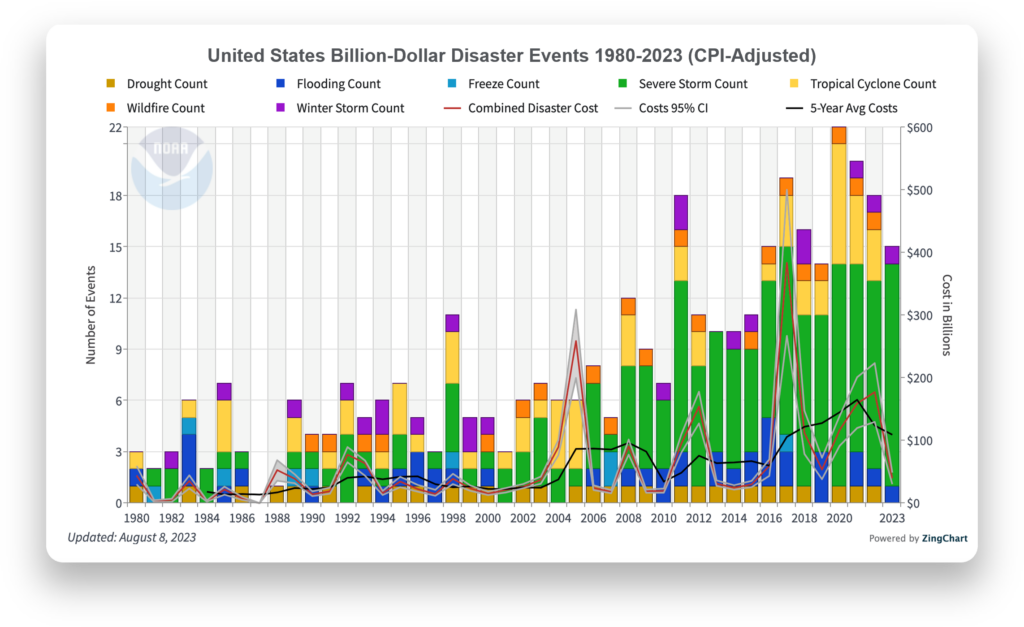It’s no surprise risks continue to rise. Security leaders see it in the headlines every day. Whether you use the term “dynamic risk” or “crisis within a crisis,” operating in today’s world means we’re never hit with just a single critical event at a time.
As we look ahead to 2024, much is on our risk radar—from the rise in man-made and natural disasters to international conflicts to cyberattacks. Though these increases are alarming, organizations and government agencies can take proactive steps to improve preparedness. As you reflect on 2023 and evaluate your plans for risk management in the coming year, here are our top predictions for what the risk landscape will look like in 2024 to help you get started:
1. Threats to geopolitical stability will persist, demonstrating how organizations and government agencies should widen their focus from “risk management” to “resilience management.”
For roughly two decades, globalization had been on the rise, and there was a sense of geopolitical stability. However, 2022 saw the beginning of the war in Ukraine, and in 2023, the Israel-Gaza war erupted. Organizations and agencies should expect and prepare for the possibility of another geopolitical instability event in 2024.
Events like these are signs of cracks starting to show in the larger global order. From a higher level, we’re seeing two major international trends competing with one another – isolationism versus multilateralism. Leaders of countries are asking themselves what their responsibilities are beyond their borders. As 2024 gets underway, the answers to this question will have cascading impacts on geopolitical stability, impacting trade, climate and the environment, and even international organizations like NATO.
Uncontrollable threats (such as those resulting from geopolitical events) are where organizations and agencies are most vulnerable, but a proactive strategy combined with modern technology can strengthen preparedness. This starts with risk, security and crisis response leaders widening their focus from the narrower concept of “risk management” to the broader idea of “resilience management.” It’s about encompassing more than just prevention and embracing a rapid discovery (and then recovery) approach.
2. The U.S. 2024 elections will expose some fragility in the American democratic system of governance, but ultimately institutions will hold.
Election year is upon us, and states will grapple with party primaries and caucuses over many months, leading up to election day on November 5. As preparations ramp up, risk, security and crisis response leaders can learn from the past to better prepare for what may come.
For example, an analysis of the historical risk data from the week of the 2020 elections (November 1, 2020, to November 7, 2020) found that several types of physical threats increased during this period compared to the two weeks prior to the election—reports of explosions increased 220 percent, shootings increased 65 percent and arson increased 38 percent during election week. While organizational and agency leaders may anticipate an increase in protests during the week of the election (and the data showed a 250 percent increase), the data shows that other types of physical threats are also likely to increase.
In addition to these types of physical disruptions that clearly pose an increased risk to public safety, we’ve also seen attempts by state and non-state actors in recent years to try to disrupt elections, and the rise of large language models (LLMs) like ChatGPT has made this easier than ever (which brings us to our next prediction).
Real-World Resilience: Examples of How Critical Event Management Technology Powers Preparedness
Discover real-world snapshots of organizations across multiple industries that are strengthening resilience and keeping people and operations safe with OnSolve.
3. 2023 saw the effective “birth” of Generative AI (ChatGPT, Google Bard/Gemini and other LLMs); 2024 will see the mass proliferation of these models.
The deep learning architecture known as the transformer first hit the scene in 2017, followed by OpenAI’s release of ChatGPT in 2022. 2023 was the year of the LLM. This has vast implications for security and resilience practitioners, both harmful and beneficial.
The past few years have been marked with increasing claims of disinformation, reaching an inflection point in 2023. Bad actors could always produce bad information; however, now the cost to scale is essentially zero. Generative AI allows for the creation of compelling and convincing content in mere seconds, so it’s never been easier to pollute the information environment.
As with any technology, there are positives and negatives. On the one hand, bad actors can use Generative AI models to intentionally proliferate misinformation. An example is the coordinated campaign to spread misinformation around the Maui wildfires. LLMs are also prone to hallucinations, in which it “perceives patterns or objects that are nonexistent or imperceptible to human observers, creating outputs that are nonsensical or altogether inaccurate.” On the positive side, the technology can create personalized content and recommendations for people, increasing productivity and engagement, and even breaking down language barriers with real-time translation and interpretation capabilities.
What does this mean for security and resilience practitioners? They will continue to wrestle with defining the “source of truth” in an environment where it is incredibly easy to create and share information online. A complicating factor is that many people are changing where they get information. For example, in the three years from 2020 to 2023, the portion of U.S. adults who get their news from TikTok has more than quadrupled.
Navigating this sea of information in 2024 will be challenging. Attempts to regulate by organizations and governments will continue.
4. Extreme weather and climate disasters will continue to dominate the work of resilience practitioners, stretch the Emergency Management Assistance Compact (EMAC) between states and government agencies, and reinforce the importance of resilience programs in private companies.
The frequency of billion-dollar natural disasters remained roughly constant until approximately 2004, when the Indonesian Tsunami occurred, followed in 2005 by Hurricane Katrina. Large events continue to rise, and the infrequent has become frequent (see NOAA chart).

Image: NOAA, United States Billion-Dollar Disaster Events 1980-2023 (CPI-Adjusted)
The financial damage alone can be devastating. 2023 has already set a record, with 25 billion-dollar disasters as of early December.
Shifts to unexpected locations are also evident: For example, OnSolve data shows Tornado Alley is moving eastward, with 57 percent of all U.S. tornado reports in the first half of 2023 being reported in the Southeast. The Canadian wildfires had far-reaching impacts, with 59 percent of U.S. air pollution reports during the first half of 2023 occurring in June. During the 2023 South Central Texas ice storm from January 30, 2023, to February 2, 2023, there was a 338 percent increase in reports of power outages and a 100 percent increase in reports of thefts compared to two weeks prior.
These events not only endanger the lives of employees and residents, but also threaten supply chains and business continuity. Organizations and government agencies should anticipate this trend of escalation will continue and plan accordingly, including leveraging technology.
5. As concerns about violence in America rise, there will be social implications for public funding, and policies related to crime and punishment.
The causality of rising violence in America is beyond the scope of this forecast, but likely correlations include the opioid epidemic, inflation, homelessness and social tensions among many groups. Active shooters/mass shootings continue to be an issue for large and small communities and organizations. Events such as the October 25 mass shooting in Lewiston, Maine, dominate the news cycle, but it’s important to note that there have been more than 600 mass shootings in 2023 as of mid-December.
The problem of violence goes beyond mass shootings. Since well before the pandemic, retail security leaders have cited concerns about increasing crime rates—from grocery theft during the early pandemic to smash-and-grab to increasingly sophisticated follow-home targeting. Organized retail crime (ORC) in particular is seeing an alarming uptick and has become a “multi-billion-dollar problem.”
Prior to the pandemic, this was primarily a concern of security teams. However, executives now recognize the far-reaching effects of violence and are looking for effective strategies to protect their organizations. Well-known retailers are pulling out of some areas, threatening the economic stability of those communities. Cities, states and the federal government are now reviewing policies for improved enforcement, resourcing and coordination, and these efforts will continue into 2024.
2024 Preparedness - What’s Your Risk Management Strategy?
The most resilient organizations in 2024 will make the shift from a prevention-only mindset to one that emphasizes a rapid discovery and recovery approach. How is this best accomplished?
Organizational and agency leaders need to leverage the power of data to strengthen preparedness. AI-powered and analyst-vetted risk intelligence helps identify current events that pose the biggest threat to people and operations in a specific location, and historical risk data can show changing patterns over a given timeframe. This helps risk and security leaders know where to focus their attention and better allocate response resources. Technology like geo-targeted alerts and two-way communications ensures the right information gets to the right people at the right time, enabling response teams to communicate before, during and after an incident and people to mark themselves safe or in need of assistance. And leaders should also prioritize collaboration and leverage relationships with industry and agency peers to share lessons learned.
As the threat landscape evolves, so too must your risk management strategy. Organizations and agencies can use these predictions and expert tips to help make 2024 the year of resilience.
For a closer look at the ways critical event management can help strengthen resilience and mitigate the impact of risk, read our ebook.


